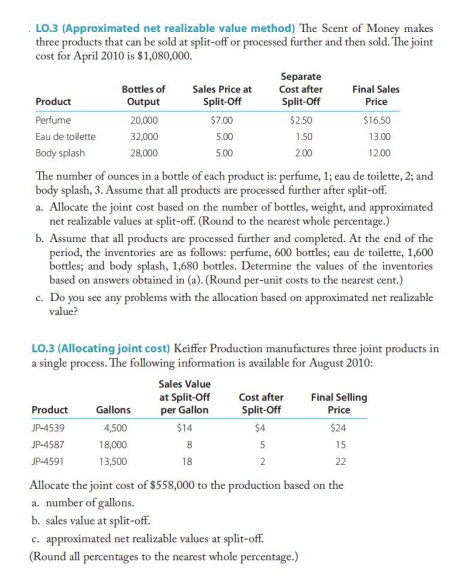LO.3 (Approximated net realizable value method) The Scent of Money makes three products that can be sold at split-off or processed further and then sold. The joint cost for April 2010 is $1,080,000. Separate Cost after Bottles of Output Sales Price at Final Sales Product Split-Off Split-Off Price Perfume 20,000 $7.00 $2.50 $16.50 Eau de toilette 32,000 500 1.50 13.00 Body splash 28,000 500 2.00 12.00 The number of ounces in a bottle of cach product is: perfume, 1; eau de toilette, 2; and body splash, 3. Assume that all products are processed further after split-off. a. Allocate the joint cost based on the number of bottles, weight, and approximated net realizable values at split-off. (Round to the nearest whole percentage.) b. Assume that all products are processed further and completed. At the end of the period, the inventories are as follows: perfume, 600 bottles; eau de toilette, 1,600 bottles; and body splash, 1,680 bottles. Determine the values of the inventories based on answers obtained in (a). (Round per-unit costs to the nearest cent.) c. Do you see any problems with the allocation based on approximated net realizable value?
LO.3 (Approximated net realizable value method) The Scent of Money makes three products that can be sold at split-off or processed further and then sold. The joint cost for April 2010 is $1,080,000. Separate Cost after Bottles of Output Sales Price at Final Sales Product Split-Off Split-Off Price Perfume 20,000 $7.00 $2.50 $16.50 Eau de toilette 32,000 500 1.50 13.00 Body splash 28,000 500 2.00 12.00 The number of ounces in a bottle of cach product is: perfume, 1; eau de toilette, 2; and body splash, 3. Assume that all products are processed further after split-off. a. Allocate the joint cost based on the number of bottles, weight, and approximated net realizable values at split-off. (Round to the nearest whole percentage.) b. Assume that all products are processed further and completed. At the end of the period, the inventories are as follows: perfume, 600 bottles; eau de toilette, 1,600 bottles; and body splash, 1,680 bottles. Determine the values of the inventories based on answers obtained in (a). (Round per-unit costs to the nearest cent.) c. Do you see any problems with the allocation based on approximated net realizable value?
Survey of Accounting (Accounting I)
8th Edition
ISBN:9781305961883
Author:Carl Warren
Publisher:Carl Warren
Chapter11: Cost-volume-profit Analysis
Section: Chapter Questions
Problem 11.16E
Related questions
Question

Transcribed Image Text:LO.3 (Approximated net realizable value method) The Scent of Money makes
three products that can be sold at split-off or processed further and then sold. The joint
cost for April 2010 is $1,080,000.
Separate
Cost after
Bottles of
Sales Price at
Final Sales
Product
Output
Split-Off
Split-Off
Price
Perfume
20,000
$7.00
$2.50
$16.50
Eau de toilette
32,000
5.00
1.50
13.00
Body splash
28,000
5.00
2.00
12.00
The number of ounces in a bottle of each product is: perfume, 1; eau de toilette, 2; and
body splash, 3. Assume that all products are processed further after split-off.
a. Allocate the joint cost based on the number of bottles, weight, and approximated
net realizable values at split-off. (Round to the nearest whole percentage.)
b. Assume that all products are processed further and completed. At the end of the
period, the inventories are as follows: perfume, 600 bottles; eau de toilette, 1,600
bottles; and body splash, 1,680 bottles. Determine the values of the inventories
based on answers obtained in (a). (Round per-unit costs to the nearest cent.)
c. Do you see any problems with the allocation based on approximated net realizable
value?
LO.3 (Allocating joint cost) Keiffer Production manufactures three joint products in
a single process. The following information is available for August 2010:
Sales Value
at Split-Off
per Gallon
Cost after
Final Selling
Product
Gallons
Split-Off
Price
JP-4539
4,500
$14
$4
$24
JP-4587
18,000
8
5
15
JP-4591
13,500
18
2
22
Allocate the joint cost of $558,000 to the production based on the
a. number of gallons.
b. sales value at split-off.
c. approximated net realizable values at split-off.
(Round all percentages to the nearest whole percentage.)
Expert Solution
This question has been solved!
Explore an expertly crafted, step-by-step solution for a thorough understanding of key concepts.
This is a popular solution!
Trending now
This is a popular solution!
Step by step
Solved in 3 steps with 6 images

Knowledge Booster
Learn more about
Need a deep-dive on the concept behind this application? Look no further. Learn more about this topic, accounting and related others by exploring similar questions and additional content below.Recommended textbooks for you

Survey of Accounting (Accounting I)
Accounting
ISBN:
9781305961883
Author:
Carl Warren
Publisher:
Cengage Learning

Survey of Accounting (Accounting I)
Accounting
ISBN:
9781305961883
Author:
Carl Warren
Publisher:
Cengage Learning